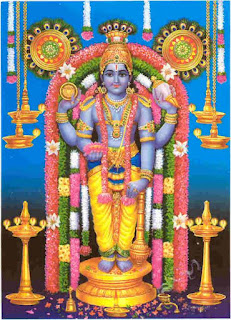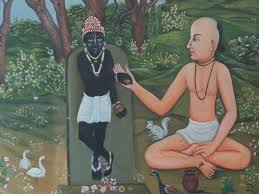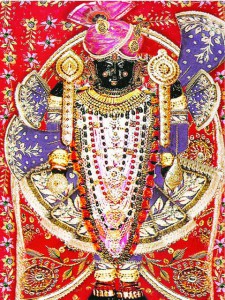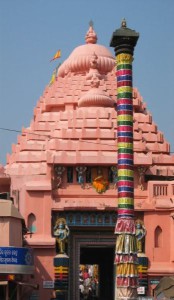Introduction to Guruvayoor Guruvayoor is a thriving township in the Thrissur district of Kerala, South India, renowned as the “Dwarka of South India.” The chief deity worshipped here is Guruvayoorappan, a form of Lord Krishna who is believed to hear and answer the prayers of His devotees. The presiding deity in the Garbhagraha (central shrine) is Mahavishnu, worshipped according to the rituals established by Adi Sankaracharya.
The Legend of Guruvayoor According to ancient lore, during the period of ‘Swayambhuva Manvantaram,’ a couple named Prajapathi Sutapa and his wife Prisni performed penance for 12,000 years before an idol of Lord Vishnu, given to them by Lord Brahma, desiring a child. Pleased by their devotion, Lord Vishnu appeared before them and granted their wish, promising to incarnate as their son in three consecutive lifetimes. In their first birth, He incarnated as Prisnigarbha. In their second birth as Kashyapa and Aditi, He incarnated as Vamana, and in their third birth as Vasudeva and Devaki, He incarnated as Lord Krishna.
Lord Krishna, after building the city of Dwarka, installed this idol in a temple there. As Krishna prepared to ascend to Vaikuntha at the end of His earthly pastimes, His disciple Uddhava became sorrowful. Krishna entrusted Uddhava with the idol, instructing him to pass it on to Brihaspati (the Guru of the Devas) to find a suitable place for its installation. With the help of Vayu (the wind god), Brihaspati searched for a sacred location. They were guided to a beautiful spot in Kerala by Lord Shiva and Parvathy, who welcomed them and blessed the place as ideal for the idol’s installation. The deity was installed by Guru and Vayu, giving the place its name—Guruvayoor—and the deity the name Guruvayoorappan. Lord Shiva and Parvathy then relocated to the opposite bank at Mammiyur, making a pilgrimage to Guruvayoor complete only with a visit to the Mammiyur Shiva temple.
The Sacredness of Guruvayoor The site of the Guruvayoor temple was already sacred due to the presence of Lord Shiva. He had previously worshipped Lord Vishnu under the waters of the ‘Rudra Teertham,’ a sacred pond near the temple. Later, when the Prachethas, sons of King Pracheenabarhis, came to worship Lord Vishnu, Shiva revealed the ‘Rudra Geetha,’ a hymn in praise of Vishnu, and the Prachethas continued their penance at Rudra Teertham for 10,000 years. This story is mentioned in the Srimad Bhagavatam.
Guruvayoor Mahatmya: Early Legends According to tradition, the great philosopher and spiritual leader Adi Shankaracharya, who typically did not endorse idol worship, was compelled to descend from his aerial journey from Kalady to Shringeri when crossing Guruvayoor. Recognizing the divine presence of Guruvayoorappan, he worshipped the deity with eight shlokas, now known as the “Govindashtakam.” He then spent 41 days worshipping Guruvayoorappan, and it is said that he conceived the daily rituals of worship during the Mandalam period at that time.
The Narada Purana recounts how King Janamejaya was cured of leprosy by taking refuge at the feet of Guruvayoorappan. After being cursed with leprosy due to his involvement in a sacrificial ritual that killed countless snakes, Janamejaya was advised by Sage Atreya to seek refuge in Lord Krishna at Guruvayoor. After ten months of devoted worship at Guruvayoor, Janamejaya was miraculously cured.
The Story of Melpathoor Narayana Bhattathiripad Melpathoor Narayana Bhattathiripad, a brilliant scholar and Brahmin, suffered from paralysis after praying to take on his guru Achyuta Pisharati’s disease. Following the advice of the great Malayalam poet Thunchathu Ezhuthachan, Bhattathiripad began composing a work narrating the various incarnations of Lord Vishnu, which became the famous “Narayaneeyam.”
As Bhattathiripad composed the Narayaneeyam, he was guided by divine inspiration from Guruvayoorappan Himself, who occasionally corrected the poet’s descriptions of His pastimes. The Narayaneeyam contains the essence of the Bhagavatam and is revered for its spiritual power, aiming for the cure of worldly ailments and ultimately seeking liberation from the cycle of birth and death.
In the final verse, “Agre Pashyami,” Bhattathiripad describes a divine vision of Lord Krishna as Venugopala, which was granted to him by Guruvayoorappan on an Ekadasi day.
Lessons to be Learned
- The Power of Devotion: The stories of Sutapa and Prisni, Uddhava, Janamejaya, and Bhattathiripad highlight the transformative power of sincere devotion and the blessings that flow from steadfast faith in the Lord.
- Divine Guidance: The legend of Guruvayoor teaches us that when we seek divine guidance with humility, the Lord Himself will guide us to the right path.
- Service to the Guru: Bhattathiripad’s willingness to take on his guru’s suffering and his subsequent devotion to Guruvayoorappan exemplify the importance of serving one’s guru with love and dedication.
- Spiritual Healing: The miraculous cures associated with Guruvayoorappan’s worship remind us of the spiritual healing power of faith and devotion, which can transcend physical and material challenges.
Prayer to Guruvayoorappan
O Guruvayoorappan, beloved Lord Krishna,
You who hear the prayers of all who seek You,
Grant me the strength to worship You with unwavering devotion,
And the wisdom to recognize Your divine presence in all that I do.
May I be guided by Your light,
And may my heart be filled with the joy of Your grace.
Let my devotion to You be as steadfast as the devotion of those who have sought You before,
And may I always find refuge in Your loving embrace.
O Lord of Guruvayoor,
May Your blessings be upon all who seek Your divine presence,
And may we all be healed by Your eternal love.



